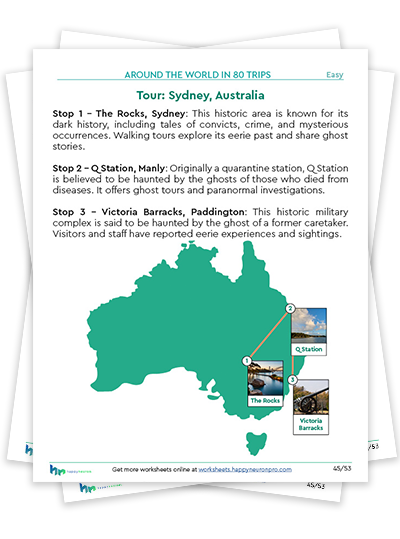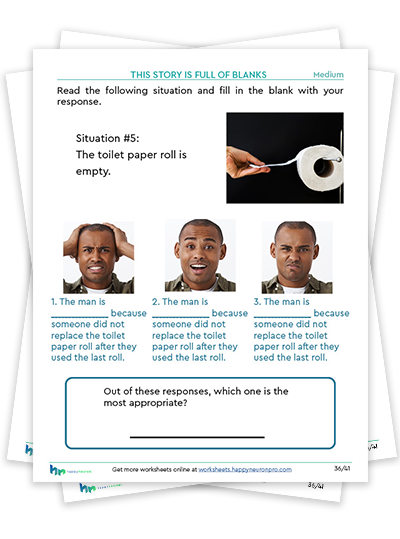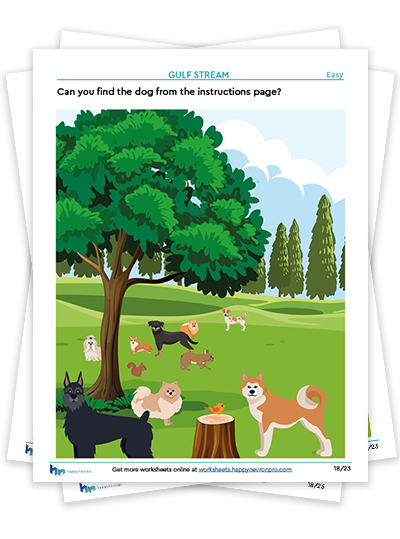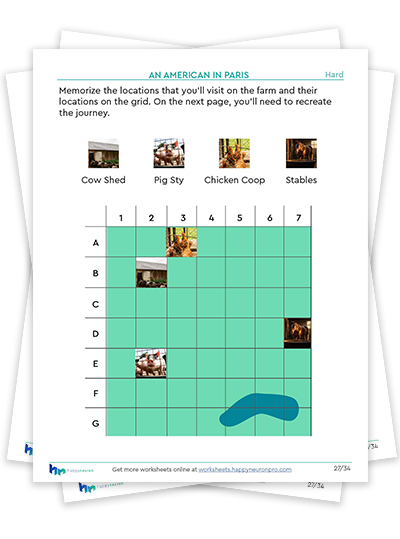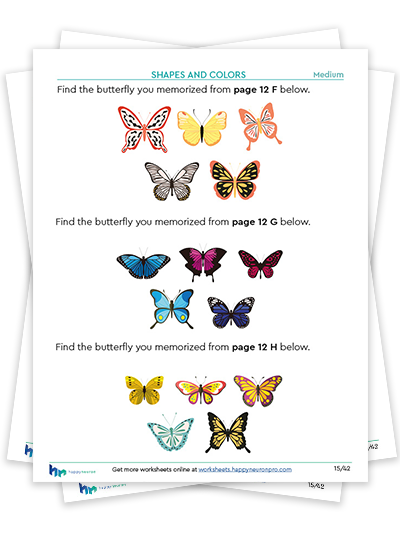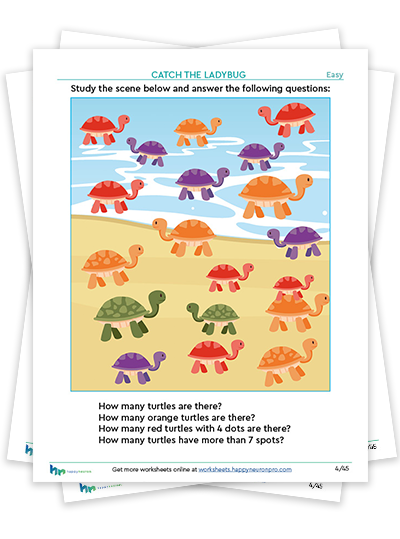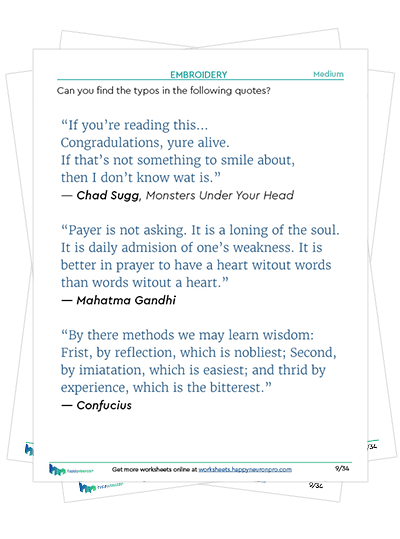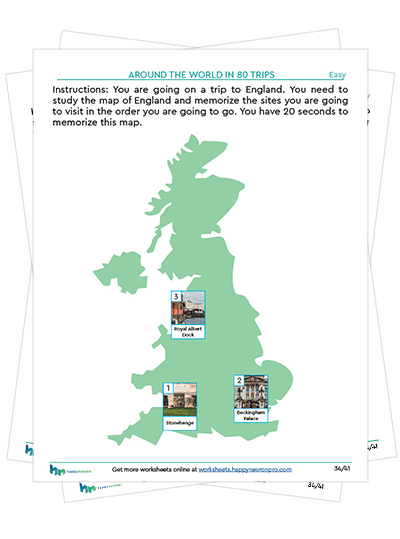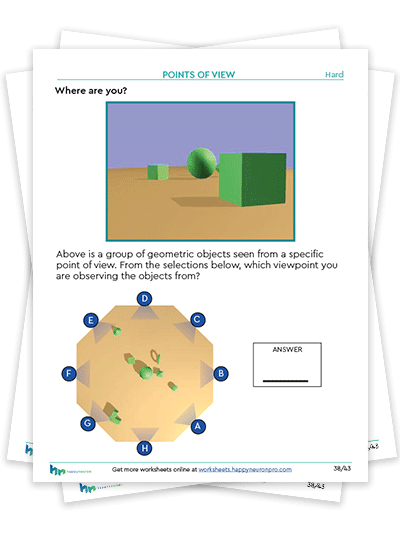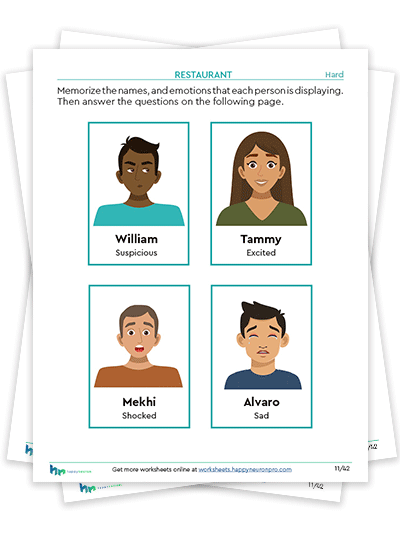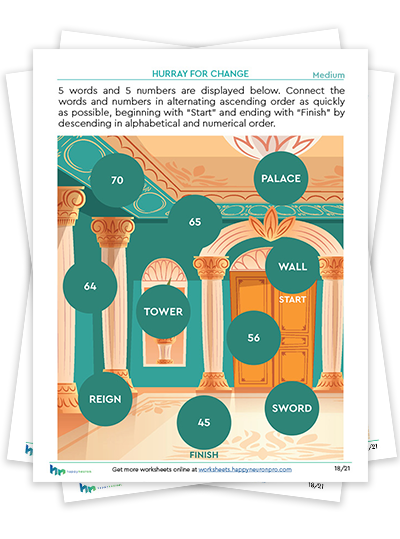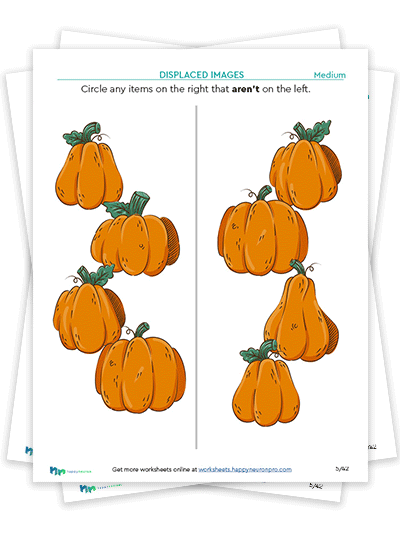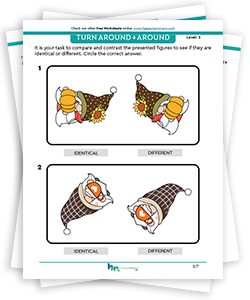Packets
Packets
Scientifically Designed Worksheets
These packets include at least 4 different exercises with each having several difficulty settings and bridging activities. Each packet focuses on a cognitive function, a medical condition, or a theme.
We release a new packet once per month and you can subscribe to get them directly in your inbox.
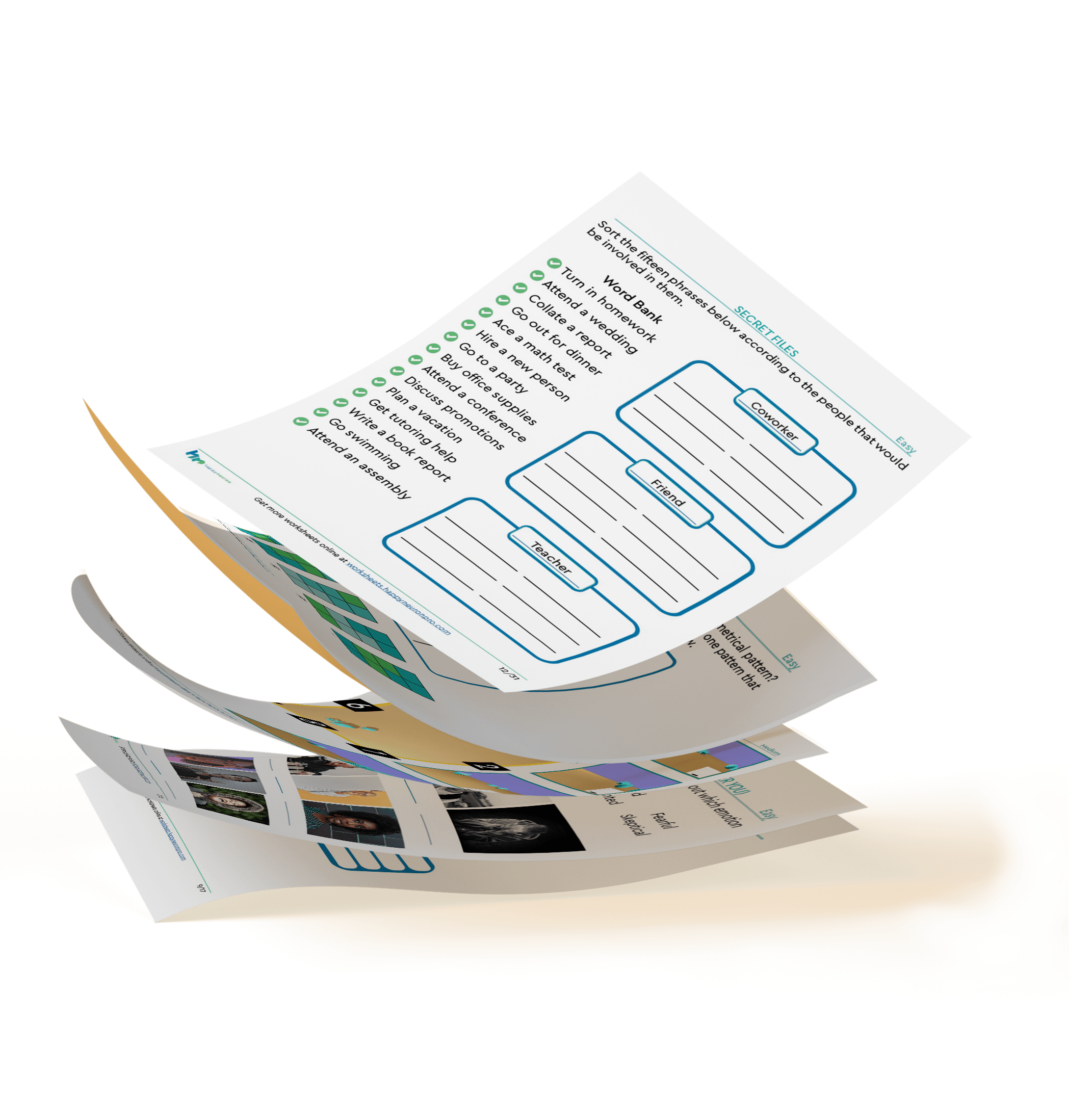
Filters
Memory
Language
Attention
Processing speed
Visual-spatial
Executive functions
Social cognition
Math and computational
Kids
Hybrid
Themed
Not purchased yet
Sort by
Prepare for a ghoulishly good time this Halloween with our Spooky Verbal Memory Printable Worksheets! These engaging and fun activities are perfect for kids and adults alike, making them ideal for Halloween parties, classroom activities, or family gatherings.
What’s Included:
- Wicked Word Match: Challenge your memory skills by matching spooky-themed words in this printed version of Displaced Characters.
- Eerie Memory Haunts: Study these spooky words and where they are on the grid. Next, place the appropriate where you saw the words. Who knew? Words, Where are You could make you feel haunted!
- Haunted Stories Parts of Speech Memory: Test your verbal recall with these Halloween-themed stories.
- Plan a Haunted Trip: Study a trip that visits real-life haunted places worldwide! Visit the homelands of all of our customers in this fun Around the World in 80 Trips activity.
👻 Why Choose Our Spooky Verbal Memory Worksheets 👻
- Professionally designed for Halloween fun.
- Suitable for all ages, from kids to adults.
- High-quality, printable PDF format.
- Instantly downloadable, so you can start the Halloween fun right away.
- Reusable for endless enjoyment year after year.
Included inside: 49 spooky verbal memory worksheets and bridging questions.
If you like this packet, explore our other memory worksheets →
Are you looking for worksheets to be used in your identifying emotions activities? Then look no further! We’ve adapted our digital exercises to help you strengthen your client’s ability to identify and express emotions. Key features of this packet are:
- Emotion Recognition: Practice recognizing emotions at a glance. We’ve adapted our digital exercise, Ancient Writing, to use modern emotion-based emojis instead. Your client will have to read the emotions and identify which one does not belong.
- Expressive Vocabulary Building: This packet encourages exploring and incorporating diverse emotional words. Whether you’re seeking to expand your vocabulary or assist others in doing so, these exercises provide an enjoyable pathway. I Remember You is now into I Understand Your Emotions.
- Working Memory Recall: Can you recall the faces of different emotions at a moment’s notice? In contrast to typical n-back exercises, this packet has a series of emojis instead of colors or letters. This exercise would work great in this packet or on its own as a warm-up.
- Situational Response Practice: Elevate your client’s interpersonal interactions with informed emotional responses! Your client will have to engage in scenario-based activities that encourage thoughtful consideration of appropriate reactions to different emotional situations. Start to develop the ability to navigate conversations and relationships with empathy and grace.
Dive into the world of emotional vocabulary, recognition, memory reinforcement, and responsive communication with our Emotion Identification Worksheet Packet. Experience the transformational power of emotional intelligence today! Unlock the potential of emotions as you’ve never done before! Teachers, enrich your classroom with this packet and teach your students about emotional intelligence. Parents, start conversations with your kids about emotions. And lastly, therapists empower your clients to think about their emotions and maybe even enhance their understanding of emotions. We recommend this packet for any age who can identify emotions.
Included inside: 36 emotion worksheets and bridging questions.
If you like this packet, explore our other social cognition worksheets →
Who let the dogs out!? Seriously, who let the dogs take over this attention worksheet? If you are looking for a great dog-themed attention worksheet, then look no further. This packet works on all major areas of attention but with a fun dog twist. Your client will have fun engaging their visual attention skills, their visual-spatial skills, and their ability to follow complex paths. Visual attention is an essential element of cognitive functions, we know that not every activity on the internet is fun and engaging. That is why we developed this fun packet to work on visual attention skills. This packet has the following exercises: Displaced Images, Gulf Stream, Dance with the Fireflies, and entangled figures.
If you enjoy these worksheets, make sure to try the digital versions of the exercises. We recommend this packet for all ages. We believe adults will benefit as much as a preschooler will as they practice this packet. We personally think the Dance with Fireflies, a dog walking path edition, is a fun way to practice working memory, visual attention, and spatial reasoning. Let us know what you think of this dog-themed attention worksheet!
Included inside: 31 worksheets and bridging questions.
If you like this packet, explore our other attention worksheets →
Yee-haw, farmers and animal enthusiasts! Get ready to wrangle your cognitive skills with our farm-themed worksheet packet. Packed with FARMtastic visuals and engaging activities, this packet is designed to enhance your visual-spatial abilities.
Unleash Your FARMtastic Skills
Saddle up for a barnyard adventure like no other as you tackle a variety of visual-spatial activities. Each activity, from corralling livestock to navigating farm landscapes, is designed to enhance cognitive function and spatial awareness. Visual-spatial skills are the backbone of cognitive function. Because of our visual-spatial abilities, we can navigate our surroundings, distinguish objects, and remember important details.
A Journey of Cognitive Development
Visual-spatial skills evolve and mature as individuals age. While some tasks may challenge younger learners, they provide valuable opportunities for growth and development. With patience and practice, even the smallest individuals can master these FARMtastic challenges. We believe individuals aged 8+ will enjoy this packet.
Digital Delights Await
For an extra dose of fun, be sure to try the digital versions of our exercises. Our American in Paris farm edition exercise offers a thrilling blend of working memory, spatial memory, and strategic planning. While it provides a FARMtastic challenge for all ages, the digital version is even better!
Perfect for Ages 7 and Up
Whether your client is a seasoned farmer or a budding enthusiast, this packet is tailor-made for individuals aged 7 and up. So saddle up, grab your boots, and get ready to cultivate your visual-spatial skills in the most FARMtastic way possible!
Included inside: 30 worksheets and bridging questions.
If you love this packet, don’t miss out on our other visual-spatial worksheets, each offering a unique opportunity to sharpen your cognitive abilities and embark on exciting new adventures. See all of our visual-spatial worksheets →
Delve into the captivating world of butterfly activities with our specialized packet designed to enhance spatial memory skills. Spatial memory plays a crucial role in our daily lives. We use it to help us navigate our surroundings, remember important locations, and recognize familiar objects. Additionally, whether we are recalling where we left our keys, identifying medication schedules, or selecting favorite products at the store, spatial memory relies on visual-spatial and attention skills to encode and retrieve information effectively.
These butterfly activities offer a unique and engaging way to sharpen cognitive abilities while exploring the beauty of nature. Whether used independently or as part of a structured therapy program, these activities offer a comprehensive approach to improving spatial memory.
Embark on a Butterfly-Themed Adventure: Immerse yourself in butterfly-themed activities that ignite the imagination and stimulate spatial memory. Each worksheet offers a delightful challenge that enhances cognitive function, from identifying colorful butterflies to navigating intricate patterns.
Enhance with Digital Chunking: Take your therapy to the next level with our digital Chunking exercise. Chunking is designed to refine spatial memory skills and offers a dynamic and interactive experience that maximizes learning and retention. Try a free round of it today!
Suitable for All Ages: Whether you’re a senior seeking cognitive stimulation or a preschooler eager to explore, our butterfly activities are designed to appeal to learners of every age. With vibrant visuals and engaging tasks, these worksheets provide valuable learning opportunities for individuals at any stage of life.
Included inside: 38 worksheets and bridging questions.
If you like this packet, explore our other spatial memory worksheets →
Embrace the spirit of Earth Day and harness the enduring strength of turtles! By engaging with our planning skills packet, they’ll not only develop essential life skills but also cultivate a deep appreciation for the planet we call home. At the heart of our cognitive rehabilitation offerings lies a profound admiration for the planet and its incredible inhabitants. Earth Day serves as the catalyst for our latest creation, a unique packet that draws inspiration from turtles’ resilient and steadfast nature. Just as these remarkable creatures inspire us with their strength and unwavering determination, we aim to inspire the development of essential planning skills in your clients through this engaging resource.
The central vision behind this packet is to challenge and enhance your client’s planning skills. In the ever-evolving world we inhabit, planning has become an indispensable skill. We not only use them to navigate daily tasks but also to overcome obstacles and adversities. Just like the determined journey a turtle makes everyday.
Why Turtles?
Turtles have long been symbols of resilience and strength. As your client engages with these exercises, we hope they’ll draw inspiration from the tenacity of turtles. Just as these creatures endure and persist. Your client can develop the skills needed to face life’s challenges head-on and emerge victorious.
Included inside: 33 worksheets and bridging questions.
If you like this packet, explore our other executive function worksheets →
Don’t let this packet fool you! Easy turns hard quickly in this language-challenging packet. Language is an essential cognitive function for communication. It can be hard to express our needs without the ability to communicate. Our goal for this packet is to challenge your clients working language skills. In this packet, your client will work on sorting skills, verbal recall, and inferring skills.
In this packet, your client must use their sorting skills and verbal recall in a series of printed Pay Attention exercises. Embroidery will challenge your client’s attention to detail and scanning skills to find the typos in famous quotes. This Story is Full of Blanks will challenge your client’s inferrer skills as they use context clues to fill in the blanks properly. Seize the Keywords in this packet is a multi-dimension challenge. It starts off by having your client label the different parts of speech from within a sentence. Then it will challenge your client’s ability to memorize different parts of speech.
This packet has parts for all ages, but we highly recommend it for 6th graders and older. Your Senior clients will love the challenges it provides, and anyone who loves correcting English will love this packet as well!
Included inside: 27 worksheets and bridging questions.
We use our memory recall skills every day. Whether it is to remember where we placed our keys or recall information from a conversation, we are constantly using our memory recall skills. This packet aims to help individuals improve their memory function by stimulating different cognitive functions involved with memory recall.
We opened this packet with several The Right Count exercises. We included these types of activities as a way to warm up visual recognization skills and executive function sorting skills. After your patient’s visual cortex is warmed up. They will have to use their spatial memory in an Object, Where are You series of exercises. There are two ways to present the next tasks. Option one is to reud the voicemail to your patient out loud and engage their auditory process skills before they answer the questions. Or you can allow them to read the section to themselves. Both of these activities will warm up their verbal memory skills. The last section of this packet is a printed version of Around the World in 80 Trips. This exercise uses all of the previous skills to challenge your patient’s memory recall skills.
The interactive and sometimes challenging tasks in this packet are an excellent resource for your memory activity collection. Working on the memory activities in this packet may improve your patient’s memory recall ability. We recommend this packet for Teens, individuals looking for memory activities, and seniors.
Included inside: 38 worksheets and bridging questions.
This packet aims to help individuals recognize items to improve their spatial awareness by studying unique key features of different objects. We hope your patient can better find themselves on a map.
We started this packet with an ancient writing task. In this task, your patient must study figures and discover which character does not appear in the section above. This will challenge their attention and working memory. Sleight of Hands is the next task. This exercise challenges your patient’s visual-spatial ability by having them mentally compare and decide if the picture displayed is a left or right hand. After that, Gulf Stream is the next task in this packet. Gulf Stream challenges your patient’s ability to remember objects and recall them as they appear on the screen. This printed version will challenge your patient’s ability to identify and find a snowflake in a mess of other snowflakes. Finally, the final exercise will test all the skills used in the previous activity. Points of View will challenge your patient’s spatial ability as your patient will try to figure out where you are on a map of objects.
In conclusion, we believe your patient will have fun completing this packet. The tasks are interactive and enjoyable, from noticing and remembering small details to mentally manipulating objects. Working on all the exercises in this packet may improve your patient’s spatial awareness. We recommend this packet for kids aged 6+, non-verbal individuals, and individuals who want to get better at figuring out where they are in time and space.
Included inside: 39 worksheets and bridging questions.
Social Cognition and Memory are the focus of this worksheet packet. This worksheet packet is packed full. 21 unique exercises span 38 pages in the packet. The key theme of this packet is emotions.
This packet will start by focusing on individuals and their emotions. Your patient must recognize emotions in each person’s face to correctly pick them out from the word box. Next, your patient will have to sort a list of emotional words alphabetically. This may help their memory recall emotion-based words in a normal sentence. After they review the bunches of emotional words, your patient will then have to memorize a list of emotions and find it in a mess of other emotions. This will use help to engage their verbal working memory. Lastly, your patient will have to do 3 different variations of root it out. The first is an unscrambled version. The second is a fill-in-the-missing letter. The last exercise is like the digital exercise Root it Out, except your patient must recall emotion-based words that start with a given letter.
From remembering people’s names and emotions to recalling emotional words, your patients will enjoy this packet. We recommend this packet for kids aged 8+ and individuals who want to work on their emotions.
Included inside: 38 worksheets and bridging questions.
Verbal Focus and Recall are the focus of this fun packet of worksheets. Your patients will have 35 unique pages of language-based exercises that may help with these skills. This packet will start by warming up their attention and sorting skills with some fun Private Eye and Hurray for Change exercises. After they complete those two segments, the harder verbal focus and recall exercises will begin. Your patient will decode a box of letters to find what word is embroidered within the grid. Verbal attention and verbal recall are challenged with these Embroidery exercises. Lastly, your patient will have to solve some Writing in the Stars exercises. Writing in the Stars will challenge your patient’s verbal processing, verbal attention, and verbal planning skills.
We recommend this packet for kids aged 8+ and individuals who want to work on their verbal skills.
Included inside: 35 worksheets and bridging questions.
Download this memory-centered action-packed packet! Your patient will have 32 unique pages filled with memory exercises with 6 pages focused on visual attention worksheets. (Yes, you read that right, we snuck in a little visual attention). We did theme this packet to have a cozy autumn feeling. We hope your patient will see how this packet will help them bridge cognitive rehabilitation therapy to real-life activities.
Displaced images will challenge your patient’s ability to see the differences between pumpkins and other autumn-themed items. Shapes and Colors may stimulate your patient’s ability to remember objects and their shapes in a mess of items. I Remember You may help your patient be able to recognize the names of the baristas at their favorite cafes. Heraldry will be the final challenge. Not only will they have to remember the shapes, colors, and patterns of mugs, but they will have to do that AFTER they sort a list of words or numbers. We hope your patients will enjoy exploring everything this packet offers.
We recommend this packet for kids aged 6+, individuals who want to work on their working memory, and anyone who loves an excellent fall-themed cognitive activity.
Included inside: 38 worksheets and bridging questions.
